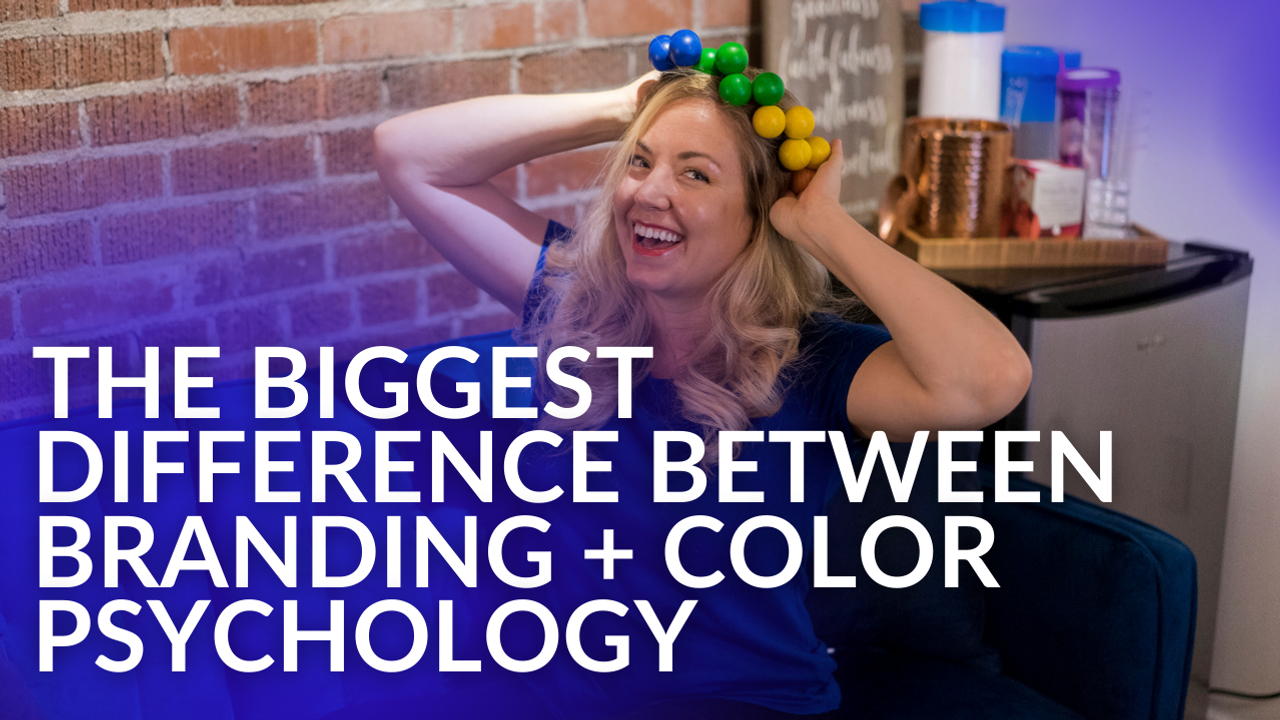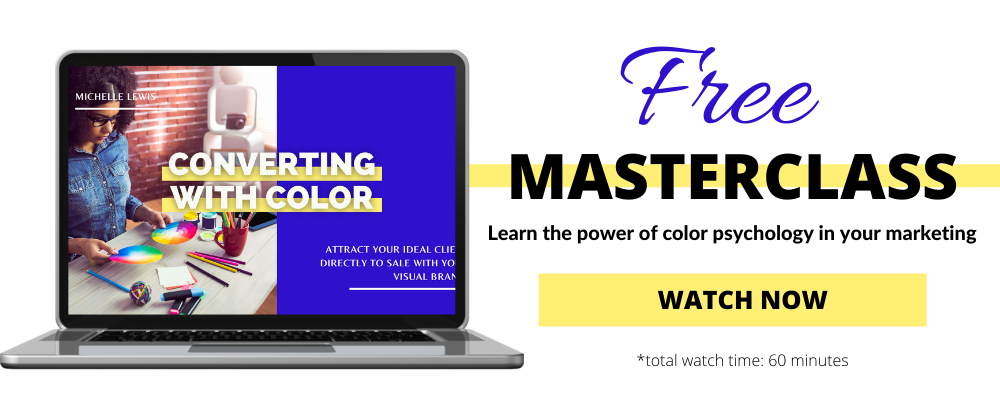The Biggest Difference Between Branding + Color Psychology
Jan 31, 2022
THE DIFFERENCE BETWEEN BRANDING AND COLOR PSYCHOLOGY
Welcome to season five of The Visible Entrepreneur! This season, we're diving deep into color, why it's needed, how to use it in your branding, and how audiences subconsciously and physically react to it. I want to help you blow up your brand, in the best way, to attract your ideal audience.
Not many people know about color psychology in branding, and even fewer are able to really teach it. This is a problem because color is one of the biggest reasons that big brands are able to sell! We have all this information thrown at us, be it on Pinterest, on YouTube, or from business coaches, and we aren’t sure what to do. We might even look up on Pinterest, “What does pink mean?” But then we get 500 different answers and it doesn’t really put us further ahead with our branding.
My goal with this season of the podcast is to break down what I know, so you can feel really confident about moving forward with your visual presence. It’s so much more than just your website. It's your brand photos. It's what you're wearing on camera every time you're interviewed. It's your press page. It's your funnels. It’s everything.
As business owners, we should have a firm grip on our colors and why we chose them. We should be able to explain this in one sentence, just like we do with our pitches or our mission statements.
We will discuss:
- My experience with color psychology
- The definition of branding
- The definition of color psychology
- Changing brand colors
- Visual presence strategy
📣 PSST... Realizing you'd rather watch/listen than read? Click play!
MY EXPERIENCE WITH COLOR PSYCHOLOGY
I have studied color psychology in a variety of ways. My degree in film and television, being on sets for 10 years, and my degree in interior design taught me a lot about color. In addition, I have studied natural medicine and how certain light frequencies are absorbed by certain healing plants, color medicine and light theory, color wheels, and Native American culture. I have immersed myself in this world, especially while building The Color Course.
If you watch the video of today’s episode, you will see my new office. I have strategically put it together using the knowledge I have about color. You will notice a lot of blues, and that I am wearing my primary brand color. You will also see green tones. Stay tuned for future episodes, where we will dig into what all of that means.
In today’s episode, we will be talking about the difference between branding and color psychology. If you want to dive into this further, I highly recommend taking the completely free color masterclass. It will give you an even more in-depth perspective and help you to start strategizing on your brand colors or adjusting them depending on where you are in the color wheel.
THE DEFINITION OF BRANDING
According to entrepreneur.com, branding is the marketing practice of creating a name, symbol or design that identifies and differentiates a product from other products. Your brand is something that you put together visually that differentiates yourself from other businesses. A logo is also often associated with branding.
Given that definition, however, there were still questions that needed answering. It seemed like there was no way to know for sure if our branding would attract and convert our ideal clients.
1: How do I know that my branding is going to attract my ideal client?
Maybe you have a brand that is more youthful, and you hope to attract a youthful audience. Maybe your brand is more luxurious, and you hope to attract a more wealthy audience. We need to draw those ideal clients in with our branding.
2: Does our branding have one primary emotional driver?
We all know that people buy based on their emotions. Most of the time they are trying to get rid of a pain point. We need to prove, through our brand, that we can address that issue.
3: Does our brand evoke a physical response?
We want to make sure that we are making a physical impact in the bodies of our ideal clients, even if it is at the subconscious level.
4: Does our branding accurately reflect the business’ personality?
We want to represent our business through a specific persona, so our visual presence has to clearly portray that to the world.
These questions kept coming up for me, and I couldn’t answer them. It was hard for me to fully explain it to my students, and they would sometimes push back when I tried to inject some color theory into our work together. They understood that branding had to attract ideal clients, but then they wondered how they fit into the equation as the business owner.
It took me a long time and a lot of study to come up with the right formulas that allow us to attract ideal clients while also reflecting our business personality. This all happens through color psychology.
I have been talking about color psychology for about five years now, and I have seen it grow in popularity over time. Explanations of different colors, however, often lack nuance. For example, you might hear people say that green means ‘wealth’. Well, green can mean ‘wealth’ in a certain context, but depending on your shade it can also mean ‘split personality’, ‘evil’, ‘rot’, or ‘decay’. So we have to be really careful when trying to associate just one emotion with one color.
THE DEFINITION OF COLOR PSYCHOLOGY
According to Wikipedia, color psychology is the study of hues as a determinant of human behavior. Color determines behavior, and we can see that in the real world. Ninety-two percent of shoppers usually buy a product based on color. When choosing a brand color, therefore, we need to keep our ideal client in mind and consider what color would encourage them to make a purchase. We want them to go from traffic, to subscriber, to customer, all based on your brand colors.
I know this can seem like a simple concept, but the more I speak on this the more people are blown away because they have never been specifically taught this. We are often taught that our brand is all about representing ourselves and our own unique personalities.
I studied specific brands like McDonald’s, Starbucks, T Mobile, and Facebook, and I saw that they completely blew their competitors out of the water because they were strategic in their branding. T Mobile is a great example, because there was no other wireless carrier that used magenta. People didn’t even really know what magenta meant. In their 2022 commercials, however, T Mobile is encouraging people to join the “Magenta Movement”.
So now that we know what color psychology is, let’s see if we can answer those four questions that we were left with after learning about branding.
1: How do I know that my branding is going to attract my ideal client?
The definition of color psychology is determining human behavior based on specific hues. Using this knowledge, we can choose a hue specifically to attract our ideal client.
2: Does our branding have one primary emotional driver?
Color equals emotion. We can choose a specific color based on how we want our ideal clients to act and feel.
3: Does our brand evoke a physical response?
We know that color impacts the body. If someone was a trauma therapist, for example, I would not recommend red in their branding. I know, based on scientific studies, that red increases the heart rate, dilates the pupils, and increases blood pressure. So that would not be appealing for their ideal clients, knowing what we know about how color hits the body.
4: Does our branding accurately reflect the business’ personality?
We can specifically adjust our tone of color to reflect our personality in our branding.
Do you see how before, with just the plain definition of branding, differentiating yourself in the marketplace did not answer these questions? These are the questions that are vital for people to make purchases. Bringing In color psychology, we're able to answer those questions. That's the empowerment. That's what is so exciting if we can understand this concept.
CHANGING BRAND COLORS
I frequently have people telling me that they have already branded and that they don’t want to spend money to rebrand. I totally get it. I would challenge you, however, to think about what your current branding might be costing you. Would it actually be a better financial decision to analyze your brand, make some tweaks, and support your color choices with color psychology in order to attract more sales?
This concept works. I have had so many clients come in without a really strong color direction. They rebranded, did the photoshoot, launched, and sold out their programs and coaching spots. If your messaging is on point and you support that messaging with your brand color, that will be the primary emotional driver of your ideal client.
VISUAL PRESENCE STRATEGY
If color psychology didn’t work, big brands would not be spending millions, if not billions, of dollars pushing their branding with a primary brand color. They know what they are doing, and they have known it for years. My job is to delineate that information and give it to you so that you feel crazy empowered to take on the challenge and to grow your brand based on that visual presence strategy.
I'd love for you to take the color masterclass - if you're ready for the in-depth explanation of what every color means, how to strategically choose your primary and secondary colors, how to integrate that into a brand palette for your web design, brand photography, stock photography, and social media. It doesn’t take long to get through - the longest part is integrating it into your brand. I will walk you step by step through that process.
If you have a business bestie or someone else you know who you think would benefit from this information, please forward this to them. If color psychology is complementary to what you teach, I would love to connect with your audience through your podcast, group, or mastermind. Just email me at [email protected].
Thanks for being here for the season five kickoff! I’m thrilled that you’re here, and I will see you again soon.
Want Updates On New Blog Releases?
We'll let you know first when they're out!
We hate SPAM. We will never sell your information, for any reason.





